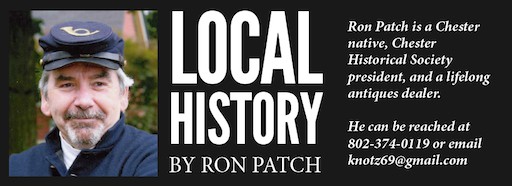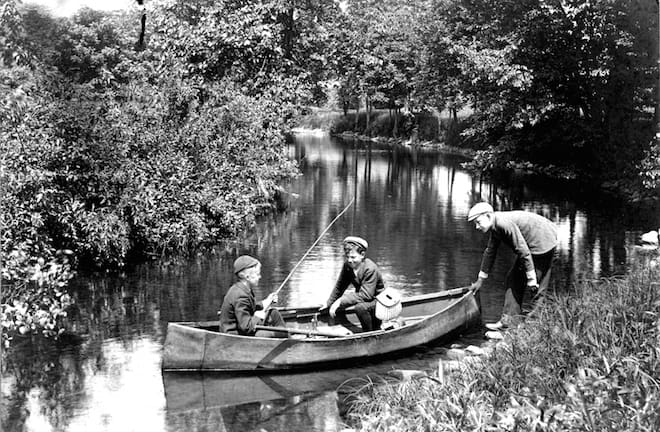
The photo with this article is in the 2021 Chester Historical Society calendar. It would date to about 1915. Tom Hildreth who scanned the photo and performed his magic in Photoshop commented, “It’s very Norman Rockwell-like.”
Two young boys sit in a homemade canoe. The boy on the left holds a stick for a fish pole. He has no reel. Line would have been cast and retrieved by hand. The other boy has a store bought fishing creel over his shoulder. An older boy is about to shove them off.

The canoe
If you look on the left end of the canoe, you can see a vertical seam where the canvas ends were joined. I don’t see any ribs like a commercial canoe. The bottom would have had several wooden slats that made up the deck for your feet. You can see two oars. It must have been a lot of fun for the boys.
The millpond
Down in the Depot was the millpond. This millpond was the water supply for Waterman’s gristmill. The dam was just below the concrete bridge we have today. This pond flooded back up the Williams River quite some distance. This is where the boys were when their photo was taken.
In the winter a large section of the pond was shoveled off for skating parties. Danny Clemons remembers clearing snow off the pond with his father Bill. Other adults and kids pitched in. Skaters built fires on the banks to keep warm. Danny says there could be four or five fires and as many as 40 skaters. Entire families showed up to skate. Lighting was provided with lanterns and four tall bridge lights.
Fishing
I grew up on the Chester village side of the tracks. I did fish here a few times when I was a kid but not often. I called Danny Clemons for his memories. Danny grew up on this side of the tracks and is older than me. Danny can remember further back than I and has a clear memory of those days.
Danny told me a few feet below the dam there was a cable. This cable was overhead and indicated this was as close to the dam as you could fish.
From this cable all the way up to the Church Street Bridge, fishing was restricted. This “no fishing” section produced some giant brown trout. Danny tells about looking off the bridge one day and seeing a huge brown trout swim by with a spinner in its mouth. Danny said it was larger than the brown Jake Howe had mounted in his barbershop. Jake’s brown went six pounds so the brown Danny saw was a monster.
Another thing Danny remembered was a red wooden box on a post. As you cross the bridge today, on the left at the end of the bridge was the red box. In the box was a guestbook. Guests would sign the book and walk out onto the concrete bridge. Here they would toss in pieces of stale bread and watch the browns surface to feed. The water would boil as they fed. Danny says people came from far and wide to feed the trout.
The dam
I vaguely remember the dam. In my day it was deteriorating. I seem to remember as I looked up the river to the dam that the left side of the dam had given way. Danny told me it was made of logs and was six or eight feet in height.
The purpose of the dam was to hold back water to power the water wheel at the gristmill. Over time, without maintenance, the dam succumbed to the elements.
Waterman’s mill
The brothers Charles H. and Roswell W. Waterman ran the gristmill. The Watermans bought the mill from a Mr. Gowing and immediately improved it. The mill had a capacity of up to 400 bushels of grain per day, a storage capacity of six carloads, with a storehouse at the Depot with seven or eight additional carloads. A carload was a railroad boxcar.
They not only ground corn and wheat from local farmers but purchased carloads of grain from the west. In total they handled over 100 boxcar loads a year.
Our 2021 calendars are available at Stone House Antiques Center, Chester Hardware, Town Hall, Smitty’s Chester Market, and Framery of Vermont.
This week’s old saying an old-timer told me describing his neighbor: “He’s so cheap he wouldn’t pay $5 for a $10 bill.”